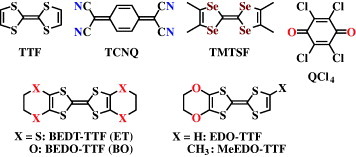Abstract
The multi-instability of the electronic structure of (EDO-TTF)2PF6, where EDO-TTF means ethylene-dioxytetrathiafulvalene, is reviewed. This complex showed the metal–insulator transition at 280 K associated with distinct molecular deformations. The mechanism is interpreted as the cooperation of Peierls transition, charge ordering, and the order–disorder transition of the countercomponent. The charge ordering pattern in the low-temperature phase is of the novel [0, 0, 1, 1] type. The sensitivity of the electronic state to external perturbations is demonstrated applying not only static but also instantaneous stimuli. In the latter case, the photo-induced phase transition is ultrafast and highly efficient. One photon causes the transition of several hundreds of donor molecules in the low-temperature phase to relax into a highly conducting metastable state within about 1.5 ps. In the early stage of the transient state, the charge ordering of the [1, 0, 1, 0] type occurs. As for the chemical modifications of this material, the partial deuteration of this complex increases the metal–insulator transition temperature. The introduction of a methyl group greatly modulates the electronic structure of the complex, i.e. (methyl-EDO-TTF)2X (X=BF4, ClO4) shows a two-dimensional electronic structure. The working hypotheses for developing the systems with multi-instability are described.
Introduction
Molecular conductors have been studied to stabilize the metallic state. Since the pioneering work on the perylene complex with bromine [Citation1], various conducting components have been developed to produce metallic charge-transfer complexes [Citation2,Citation3]. The first organic metal tetrathiafulvalene (TTF) (TCNQ) is a one-dimensional conductor that shows the metal–insulator transition at 54 K due to Peierls instability. By increasing the dimensionality of the electronic structure to inhibit metal–insulator transition, TMTSF and BEDT-TTF have provided representative organic superconductors with quasi-one-dimensional and two-dimensional electronic states, respectively. The highest superconducting transition temperatures for molecular materials are recorded for C60 complexes intercalated with alkali metals, which show three-dimensional electronic structures. In the course of the development of molecular superconductors, various metal–insulator transition mechanisms were proved, e.g. Peierls transition, spin density wave transition, the order–disorder transition of the countercomponent and charge ordering.
These transitions are the responses of itinerant electrons to a temperature variation. As for the susceptibility of the electronic systems to environmental modulations, electric field, magnetic field, light, static pressure and uniaxial strain have been applied to investigate the responses of molecular conductors. Although most stimulations are applied statically on the time scale of the measurements, recent technological developments enabled irradiation by ultra-short light pulses [Citation4]. This technique allowed studying the relaxation from the nonequilibrium state with a time resolution <0.1 ps.
In the course of our investigation on molecular conductors, TTF derivatives with ethylenedioxy (EDO) group(s) have been examined [Citation5]. The first compound in this category, BEDO-TTF (BO), in which two EDO groups are incorporated in a molecule, shows a self-assembling nature. This donor molecule strongly tends to construct the conducting layer with the specified packing pattern in charge-transfer complexes [Citation6]. In the donor layer, the intermolecular short contact between heteroatoms and the C–H···O hydrogen bond network concertedly stabilizes the crystal structure. Owing to the two-dimensional nature of the conducting layer, the complexes almost exclusively exhibit a metallic behavior down to low temperatures. In contrast, EDO-TTF, which is formally derived from BO by removing one of the EDO groups, exhibits no self-assembling nature observed for BO [Citation7]. This indicates that the metallic state of the EDO-TTF complex can be unstable. In fact, to the best of our knowledge, all the charge-transfer complexes of EDO-TTF exhibit a nonmetallic ground state at low temperatures. Among them, the metal–insulator transition observed for (EDO-TTF)2PF6 demonstrates the multi-instability of the metallic state [Citation8]. Furthermore, the low-temperature insulator state exhibits an ultra-fast and highly efficient photo-induced phase transition [Citation9,Citation10]. In these transitions, the correlation between the electric state and lattice (and/or molecular) vibration is important. These thermally and photo-induced transitions are reviewed in this paper along with the brief descriptions of recent results for the related materials.
Multi-instability of the metallic state of (EDO-TTF)2PF6
(EDO-TTF)2PF6 was prepared by electrocrystallization [Citation8]. The crystal structure consisted of alternating donor and anion layers in a triclinic unit cell. In the donor layer, columnar stacks were formed by the head-to-tail-type overlapping of donor molecules, as shown in figure . Although the octahedral anion can inherently be located at the center of inversion without disorder, the PF6 anion in this complex showed rotational disorder at the origin of the unit cell at room temperature. Based on the charge and packing pattern of the donor molecules, the band structure was calculated under a tight binding approximation to show a quasi-one-dimensional Fermi surface. The nesting vector was expected to be parallel to the direction of a∗+b∗ (inset in figure ).
Figure 1 Crystal structures of room-temperature and low-temperature phases of (EDO-TTF)2PF6 (left and right panels, respectively). The dihedral angles of the central and outer planes consisting of C2S4 moieties, θ1 and θ2, were 6.0° and 0.3° for the donor molecule in the room-temperature phase, whereas they were 11.1° and 7.9°, and 0.8° and 2.1° for the bent and flat molecules in the low-temperature phase, respectively. The numbers between the molecules indicate the intermolecular overlap integrals in 10−3 units. In the right panel, the approximated charges of 1+ and 0 are indicated for the flat and bent molecules, respectively. The equator of the uniaxial rotation of the anion in the low-temperature phase is almost parallel to the panel of this figure [Citation8].
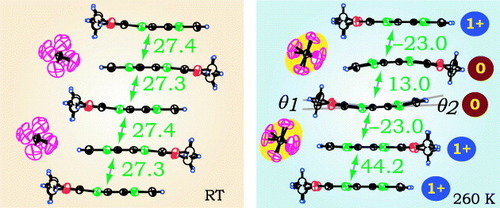
Figure 2 Temperature dependence of (EDO-TTF)2PF6 resistivity. The inset shows the Fermi surface along with the expected nesting vector (thick arrow) [Citation8].

Temperature-dependent resistivity showed an abrupt metal–insulator transition at 280 K, very close to the room temperature (figure ). The data for the low-temperature phase was difficult to collect owing to the very brittle nature of the crystal at the transition. This transition was also observed by magnetic susceptibility measurement. The weak paramagnetism observed for the metallic phase vanished for the insulating phase. The switching between the paramagnetic and nonmagnetic behaviors showed a hysteresis to a temperature variation, and hence, this metal–insulator transition was designated as a first-order transition.
The crystal structures of the metallic and insulating phases were compared. Although one EDO-TTF molecule was crystallographically unique and showed an almost planar shape at room temperature, two donor molecules were independent at 260 K, and showed more bent and flattened shapes than that in the room-temperature phase (see figure ). The distinct deformation of the conducting component molecules associated with the metal–insulator transition is peculiar. To the best of our knowledge, only two BEDT-TTF complexes show a similar structural feature, while the multi-instability described below for (EDO-TTF)2PF6 is not proved in these cases [Citation11,Citation12].
To understand the mechanism of the metal–insulator transition, the unit cells of the metallic and insulator phases were compared to prove that the doubling of the former along the a+b direction gives the latter. The doubling of the periodicity of donor arrangement corresponded well with the nesting vector, and hence, the transition implies the Peierls transition mechanism. Judging from intramolecular bond lengths, the bent and flat molecules in the low-temperature phase were regarded to be charged less and more, respectively. Thus the charge ordering is also included in this metal–insulator transition, and the arrangement of charge-poor and charge-rich sites is unique. Although one might naively expect that the Coulomb repulsion of the neighboring sites would produce [1, 0, 1, 0, …] type arrangement, the [0, 0, 1, 1] ordering was observed in this complex corresponding to the alignment of the bent and flat molecules. Later, the coexistence of charge-poor and charge-rich molecules was proved by Raman spectra [Citation13] and by accurate x-ray structure analysis [Citation14], and the latter directly determined the arrangement of charge-disproportionated EDO-TTF molecules. Furthermore, the disorder of the anion was suppressed even at 260 K to exhibit a uniaxial rotation. The periodicity of the anion arrangement was also doubled in the low-temperature phase compared with that in the room-temperature phase. Hence, order–disorder transition is also included in this metal–insulator transition. As a result, the metallic state of (EDO-TTF)2PF6 shows the multi-instability. The mechanism of the transition observed for this complex is designated as the cooperation of three mechanisms. The origin of the mixing of the mechanisms is suspected to be the deformation of the conducting component during the transition. In other words, the multi-instability is presumed to be the result of molecular flexibility.
Corresponding to the transport behavior, the metallic phase showed a strong increase in the low energy region of the reflectivity spectra, as shown in figure [Citation15]. In contrast, the insulator phase exhibited two relatively sharp peaks at around 5 and 11×103 cm−1 indicated as CT1 and CT2, respectively. In the lower energy region, the spectrum of the high-temperature phase was distorted right above 1×103 cm−1, which should be due to electron–molecular vibration coupling, whereas the spectrum of the low-temperature phase exhibited typical vibrational bands.
Figure 3 Temperature-dependent reflectivity spectra of (EDO-TTF)2PF6 [Citation13].

The charge ordering in the insulator phase was proved by Raman spectra indicating the charges of charge-poor and charge-rich molecules as + 0.04 and + 0.96, respectively, at 6 K [Citation15]. The direct evidence for the [0, 0, 1, 1] type charge-ordering pattern was obtained by an accurate crystal structure analysis with a maximum entropy method, indicating the degree of charge disproportionation as + 0.2(1) versus + 0.8(1) at 260 K [Citation16]. It is noteworthy that a calorimetric study also indicated that this metal–insulator transition is a catastrophic result of multiple instabilities. Additionally, this investigation suggested the restricted rotation of the anion in the metallic phase [Citation17].
Photo-induced phase transition of (EDO-TTF)2PF6
The multi-instability of the electronic state implies the sensitivity of the electronic state to environmental modulations. In fact, the uniaxial strain perpendicular to the conducting layer of (EDO-TTF)2PF6 increased the metal–insulator transition temperature markedly (>60 K at 4 kbar) [Citation18].
The susceptibility to an instantaneous stimulus was proved by the examination of the photo-induced phase transition (PIPT) [Citation9,Citation10]. By irradiating laser light with a pulse width of 0.12 ps, the low-temperature phase of the complex showed an abrupt change in reflectivity. The characteristic features of this PIPT are as follows. The system exhibited an ultra-fast response, in which only about 1.5 ps was required for the photo-induced initial state to relax into the metastable state. Light efficiency was excellent, since it was estimated that one photon converted the domain in the crystal containing 50–500 donor molecules. The reflectivity change exceeded 100% in the energy region right above that of CT2 (see figure ). To induce this PIPT, a certain pump light intensity was required. The threshold for providing the metastable state was estimated as one photon for every 1500 donor molecules. The lifetime of the metastable state depended on the pump light intensity. The reflectivity relaxed back within about 1.5 ps when a pulsed laser light with the threshold intensity (2.1×1014 photons cm−2 for the pump light energy of 12.5×103 cm−1) was used for irradiation, while the photo-induced state persisted for several hundred microseconds when the photon density of the pump light was increased threefold. Although the time resolution of the transport measurements was much slower (about 1 μs) than the reflectivity change (about 0.1 ps), it was proved that the photo-induced state has high bulk conductivity. In the early stage of the PIPT, the reflectivity showed a periodic modulation that changed with time. This vibration was designated as the coherent peaks, the most plausible origin of which is the strong coupling between the electronic and vibrational states in this complex. The period of the vibration was about 0.5 ps, which corresponded to a wavenumber of 70 cm−1. It is interesting to note that a Raman peak observed at 85 cm−1 at 30 K and the frequency of the above-mentioned coherent peak showed similar softening by heating. These results imply that the vibrations in this energy region, which are assigned as the skeletal molecular vibration or intermolecular vibration (phonon), affect the photo-induced electronic phase transition of the system.
Figure 4 Time evolution of change in the reflectivity of (EDO-TTF)2PF6 after irradiation by pulsed laser light with intensity of 6.4×1014 photons cm−2 at different temperatures. The wavenumbers of the pump and probe lights were 12.5 and 13.9×103 cm−1, respectively. Asterisks indicate coherent peaks [Citation9].
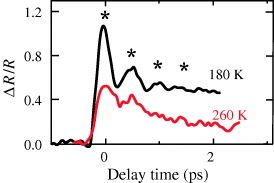
Since the initial time can be controlled, PIPT systems are suitable for the study of the dynamics of nonequilibrium states. It is interesting to compare the above-mentioned material with other systems. Almost the same rate of the photo-induced process was reported for K (TCNQ), the ground state of which is designated as the spin Peierls state. In that case, about 20 molecules were affected by one photon [Citation19]. The melting of charge ordering was reported for θ-(ET)2RbZn(SCN)4 and α-(ET)2I3 with response times and efficiencies similar to those of (EDO-TTF)2PF6 [Citation20,Citation21]. As for the charge-transfer complex consisting of mixed stacks of donor and acceptor molecules, the neutral-ionic transition system (TTF) (QCl4) has been intensively studied. This complex showed a relatively slow response, in which around 1 ns was required for the photo-induced state to propagate over about 410 formula units [Citation4]. Although in all cases, including the title complex, experimental difficulties resulted in a high uncertainty on the efficiency, (EDO-TTF)2PF6 is regarded as a good material for showing the cooperativity in the PIPT process.
The first report on the PIPT of (EDO-TTF)2PF6 concentrated on the reflectivity change around the CT2 band, which seemed consistent with that of the thermally induced insulator-to-metal transition. However, recent studies of the optical conductivity spectra in a wider energy range provided another model of the photo-induced state [Citation22]. By observing the reflectivity at 0.1 ps after the pump irradiation of the low-temperature phase, in a wide energy range (0.56–16.9×103 cm−1), the optical conductivity spectrum was derived, as shown in figure . The spectrum of the photo-induced state showed discrepancy with that of the thermally generated metallic state, particularly in the low-energy region, and it was different from that of the low-temperature phase. Also, the coherent peaks were observed only at energies above 4×103 cm−1, whereas the irregular vibrations were detected below 3.2×103 cm−1 and could be noise. To understand the spectral feature of the transient state, which showed a single peak at around 3.2×103 cm−1, a theoretical calculation was carried out. The Hamiltonian concerned the intermolecular transfer integral, on-site and neighboring-site Coulomb repulsions, and electron–phonon coupling including the modulation of the anion potential due to structural displacements. Time-dependent solutions showed the evolution of the lattice and site charge fluctuations. As a result, the [1, 0, 1, 0, …] type charge ordering state with a fluctuated lattice was estimated as the early stage of the PIPT. Detailed study of the metastable state derived from this initial stage is under way.
Figure 5 Static and photoinduced optical conductivity spectra of (EDO-TTF)2PF6 derived by Kramers–Kronig transformation of reflectivity spectra. HT and LT show the spectra of the high- and low-temperature phases, respectively. PI exhibits the spectra at 0.1 ps after the illumination at 1.58 eV (12.7×103 cm-1) with the pulse width and intensity of 0.12 ps and 8×1015 photons cm-2, respectively, at 180 K [Citation22].
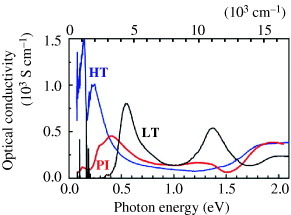
Chemical modification of (EDO-TTF)2PF6
New materials are indispensable for the development of a new scientific field. To study the dynamics of nonequilibrium states, highly efficient PIPT systems are desired. To realize phase transition systems similar to (EDO-TTF)2PF6, chemical modifications of this complex are being carried out. As the minimum modification, the vinyl proton of the donor molecule was substituted with deuterium. The metal-insulator transition temperatures of the PF6 and isostructural AsF6 complexes were increased by about 3 K compared with pristine complexes. A detailed comparison of the vibrational spectra proved that not only the C–H(D) vibration but also the modes consisting mainly of π-conjugated skeletal vibrations were affected by the isotopic substitution [Citation23].
Molecular deformation of the donor molecule during metal-insulator transition is regarded to play an important role in showing the multi-instability of (EDO-TTF)2PF6. Therefore, it is indispensable to examine the conducting component molecules with similar π-electron systems, molecular sizes and flexibilities. MeEDO-TTF was studied as an example. Among the complexes with inorganic closed-shell anions, the isostructural complexes (MeEDO-TTF)2X (X=BF4, ClO4) exhibited stable metallic behaviors down to 10 K. Although the electronic state was estimated as two-dimensional from the calculated band structure, intermolecular interactions were relatively weak (figure ). Hence, these complexes are regarded as metals, which are located near the insulators in a phase diagram [Citation24]. In fact, the isostructural complex of X=PF6 showed a semiconducting behavior [Citation25].
Figure 6 a-axis projection of donor layer in (MeEDO-TTF)2ClO4. The calculated intermolecular overlap integrals are t=11.3, p=8.5 and s =−5.4×10−3 [Citation24].
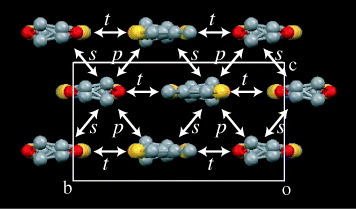
Concluding remarks
From the viewpoint of instrumental analysis, the results mentioned above demonstrate the progress in the studies on the dynamics of nonequilibrium states. In future, developments of techniques, such as the pump–probe method with shorter pump and probe pulses, will characterize the very early stage of a phase transition.
As for the materials, although the multi-instability of (EDO-TTF)2PF6 was unexpectedly discovered, analogous materials are being actively examined. Whereas the approach to obtain itinerant electron systems with multi-instability should not be unique, the analysis of (EDO-TTF)2PF6 shows the following requirements to produce the systems similar to this complex:
the conducting component should provide one-dimensional or quasi-one-dimensional electronic structures of the complex,
the neighboring-site Coulomb repulsion should be significant,
the countercomponent with an anisotropic molecular shape is preferred,
the most stable molecular configuration of the conducting component should be altered depending on its charge, and
the molecular size of the conducting component should be relatively small.
The requirements 1–3 correspond to the instabilities of Peierls transition, charge ordering transition, and order–disorder transition, respectively, whereas 4 and 5 are related to the possibility of a molecular deformation that will induce the cooperation of metal–insulator transition mechanisms. As a result, relatively small π-electron systems are candidates for new materials with multi-instability, which are susceptible to faint stimuli.
References
- AkamatuHInokuchiHMatsunagaY 1954 Nature 173 168 http://dx.doi.org/10.1038/173168a0
- FraxedasJ 2006 Molecular Organic Materials Cambridge Cambridge University Press
- IshiguroTYamajiKSaitoG 1998 Organic Superconductors (Springer Series in Solid-State Sciences) vol 88 2nd edn Berlin Springer
- KoshiharaSTakahashiYSakaiHTokuraYLutyT 1999 J. Phys. Chem. B 103 2592 http://dx.doi.org/10.1021/jp984172i
- YamochiH 2004 Chapter 4. Oxygen analogues of TTFs TTF Chemistry JYamada TSugimoto Tokyo Kodansha
- HoriuchiSYamochiHSaitoGSakaguchiKKusunokiM 1996 J. Am. Chem. Soc. 118 8604 http://dx.doi.org/10.1021/ja960393v
- OtaAYamochiHSaitoG 2002 Mol. Cryst. Liq. Cryst. 376 177
- OtaAYamochiHSaitoG 2002 J. Mater. Chem. 12 2600 http://dx.doi.org/10.1039/b206293c
- CholletM et al 2005 Science 307 86 http://dx.doi.org/10.1126/science.1105067
- KoshiharaSAdachiS 2006 J. Phys. Soc. Japan 75 011005 http://dx.doi.org/10.1143/JPSJ.75.011005
- DoubletM-LCanadellEShibaevaP 1994 J. Phys. I France 4 1479 http://dx.doi.org/10.1051/jp1:1994202
- OtaAOuahabLGolhenSYoshidaYMaesatoMSaitoGSwietlikR 2007 Chem. Mater. 19 2455 http://dx.doi.org/10.1021/cm063036k
- DrozdovaOYakushiKYamamotoKOtaAYamochiHSaitoGHashiroHTannerD B 2004 Phys. Rev. B 70 075107 http://dx.doi.org/10.1103/PhysRevB.70.075107
- AoyagiSKatoKOtaAYamochiHSaitoGSuematsuHSakataMTakataM 2004 Angew. Chem. Int. Ed. 43 3670 http://dx.doi.org/10.1002/anie.200454075
- DrozdovaOYakushiKYamamotoKOtaAYamochiHSaitoGHashiroHTannerD B 2004 Phys. Rev. B 70 075107 http://dx.doi.org/10.1103/PhysRevB.70.075107
- AoyagiSKatoKOtaAYamochiHSaitoGSuematsuHSakataMTakataM 2004 Angew. Chem. Int. Ed. 43 3670 http://dx.doi.org/10.1002/anie.200454075
- SaitoKIkeuchiSOtaAYamochiHSaitoG 2005 Chem. Phys. Lett. 401 76 http://dx.doi.org/10.1016/j.cplett.2004.11.031
- SakataMMaesatoMOtaAYamochiHSaitoG 2005 Synth. Met. 153 393 http://dx.doi.org/10.1016/j.synthmet.2005.07.314
- OkamotoHIkegamiKWakabayashiTIshigeYTogoJKishidaHMatsuzakiH 2006 Phys. Rev. Lett. 96 037405 http://dx.doi.org/10.1103/PhysRevLett.96.037405
- TajimaNFujisawaJNakaNIshiharaTKatoRNishioYKajitaK 2005 J. Phys. Soc. Japan 74 511 http://dx.doi.org/10.1143/JPSJ.74.511
- IwaiSYamamotoKKashiwazakiAHiramatsuFNakayaHKawakamiYYakushiKOkamotoHMoriHNishioY 2007 Phys. Rev. Lett. 98 097402 http://dx.doi.org/10.1103/PhysRevLett.98.097402
- OndaK et al 2008 Phys. Rev. Lett. 101 067403 http://dx.doi.org/10.1103/PhysRevLett.101.067403
- NakanoYBalodisKYamochiHSaitoGUruichiMYakushiK 2008 Solid State Sci. 10 1780 http://dx.doi.org/10.1016/j.solidstatesciences.2008.01.020
- ShaoX FNakanoYYamochiHDubrovskiyA DOtsukaAMurataTYoshidaYSaitoGKoshiharaS 2008 J. Mater. Chem. 18 2131 http://dx.doi.org/10.1039/b717621j
- ShaoX F et al 2008 Chem. Mater. 20 7551 http://dx.doi.org/10.1021/cm802517s
